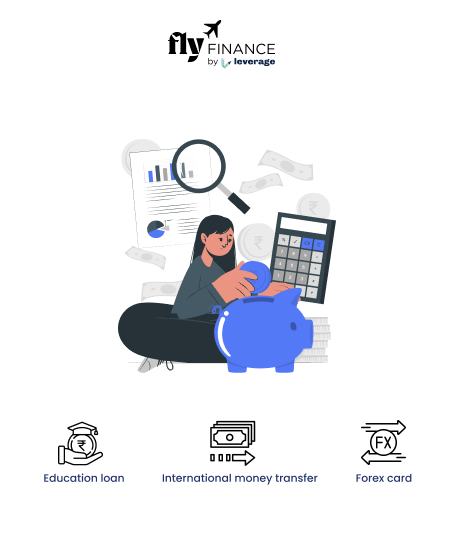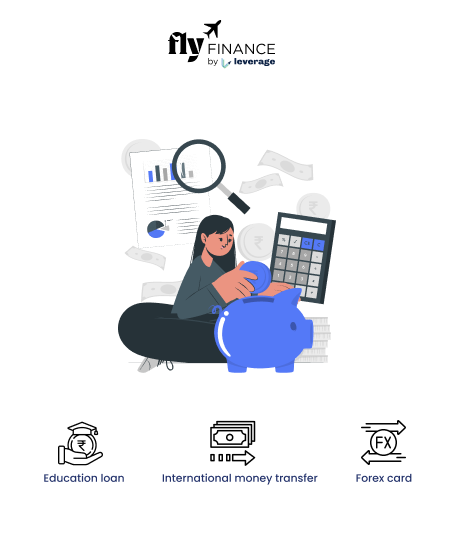The full form of FEMA is the Foreign Exchange Management Act. It was passed by the Reserve Bank of India in 1999 and helps the government make decisions in matters of India’s foreign trade policy. It lays a set of rules and regulations relating to foreign exchange and prevents cases of money laundering by keeping a tight check on the amount of currency taken out from the country.
It was enacted to replace the Foreign Exchange Regulation Act (FERA), 1973, which was more restrictive in nature. Let’s dive into more important details about what is FEMA, its full form, features, objectives, and essential regulations that international students must know.
Table of contents
What is the FEMA Act, of 1999?
FEMA is a Foreign Exchange Management Act passed on 29 December 1999 by the Reserve Bank of India. It replaced the older Foreign Exchange Regulation Act (FERA). FEMA Act, of 1999 lays down a set of regulations on foreign exchange and the amount of money that can be taken out of the country for business purposes, travelling, medical reasons, or to study abroad.
The primary aim of FEMA is to promote external trade and payments while ensuring the orderly development and maintenance of the foreign exchange market in India. Unlike FERA, which treated violations as criminal offences, FEMA classifies them as civil offences, making compliance more accessible for individuals and businesses.
Why was FEMA Needed?
Before the Foreign Exchange Management Act (FEMA), 1999, India followed the Foreign Exchange Regulation Act (FERA), 1973. FERA was highly restrictive and treated most foreign exchange transactions as serious offences. This made international trade, foreign investments, and even simple remittances difficult for businesses and individuals.
However, in the 1990s, India’s economy started opening up to the world. To encourage growth, attract foreign investments, and simplify foreign exchange transactions, the government introduced FEMA in 1999.
How Did FEMA Help?
- Easier Foreign Transactions – FEMA made sending and receiving foreign currency smoother by setting clear rules and reducing unnecessary restrictions.
- Encouraged Foreign Investments – Unlike FERA, which discouraged foreign companies from investing in India, FEMA created a business-friendly environment, attracting Foreign Direct Investment (FDI) and Foreign Portfolio Investment (FPI).
- More Flexibility, Less Penalty – Under FERA, violations were treated as criminal offences. FEMA replaced this with civil penalties, making compliance easier.
- Support for Global Trade – Indian businesses could now trade internationally without excessive regulations, boosting economic growth.
Also Read: Discover the significant differences between FERA and FEMA and their impact on India’s economy. Understand their objectives, structure, and influence.
Features of FEMA
The FEMA Act, of 1999, was introduced to create a more flexible framework for managing foreign exchange transactions in India. This act replaced the older Foreign Exchange Regulation Act (FERA). FEMA emphasizes a liberal approach, treating violations as civil offences rather than criminal ones, which helps streamline compliance and encourage foreign investment. Below are the key features of FEMA:
| Features | Description |
| Regulation of Transactions | FEMA regulates transactions between residents and non-residents, ensuring compliance with guidelines. |
| Current and Capital Account Transactions | It differentiates between current account transactions (like trade) and capital account transactions (like investments). |
| Freely Permissible Transactions | Current account transactions are generally allowed without restrictions, subject to reasonable limits. |
| Role of RBI and Central Government | The Reserve Bank of India (RBI) and the Central Government oversee capital account transactions. |
| Realization and Repatriation | It mandates the realization of export proceeds and their repatriation to India within specified timeframes. |
| Authorized Persons | Transactions must be conducted through authorized dealers, money changers, or offshore banking units. |
| Adjudication and Compounding of Offences | FEMA provides mechanisms for adjudicating violations and compounding offences related to foreign exchange. |
| Enforcement by Directorate of Enforcement | The Directorate of Enforcement is responsible for investigating violations and enforcing compliance with FEMA provisions. |
| Appeal Provisions | The Act includes provisions for appeals to the Special Director (Appeals) and Appellate Tribunal for Foreign Exchange. |
| Penalties for Violations | FEMA imposes penalties for non-compliance, including fines, confiscation of assets, and prosecution for serious violations. |
Objectives of FEMA
The Foreign Exchange Management Act (FEMA), enacted in 1999, serves several key objectives aimed at facilitating external trade and payments while promoting the orderly development and maintenance of the foreign exchange market in India. Here are the primary objectives of FEMA:
- Facilitate External Trade: FEMA aims to simplify and enhance the process of conducting international trade by allowing businesses and individuals easier access to foreign exchange.
- Promote Foreign Investment: The Act encourages foreign investments in India by providing a regulatory framework more conducive to investment flows.
- Manage Foreign Exchange: FEMA establishes guidelines for managing foreign exchange transactions, ensuring that they are conducted orderly to mitigate risks associated with currency fluctuations.
- Support Economic Stability: By regulating foreign exchange, FEMA helps maintain economic stability and supports the country’s overall financial health.
- Liberalized Remittance Scheme (LRS): The Act includes provisions for the LRS, which allows residents to remit a specified amount abroad for various purposes without needing prior approval from the Reserve Bank of India (RBI).
Classification of Transactions under FEMA
Under the Foreign Exchange Management Act (FEMA), 1999, foreign exchange transactions are broadly classified into two categories:
- Current Account Transactions
- Capital Account Transactions
Current Account Transactions
These are transactions related to day-to-day international trade, business, and personal expenses. They do not affect the country’s assets or liabilities in the long run.
Examples of Current Account Transactions:
– Payments for imports and exports
– Education expenses and foreign travel expenses
– Medical expenses abroad
– Interest payments on loans
– Remittances (sending money abroad for family maintenance)
Regulation:
- Freely Allowed unless specifically restricted by the RBI (Reserve Bank of India) or the Government of India.
- Some transactions require prior approval, such as large remittances or payments for prohibited activities.
Capital Account Transactions
These involve the movement of capital (money used for investments, loans, or assets) between India and foreign countries. These transactions directly affect India’s assets and liabilities.
Examples of Capital Account Transactions:
– Foreign Direct Investment (FDI) and Foreign Portfolio Investment (FPI)
– Investment in foreign companies, stocks, or real estate
– Taking or repaying loans between residents and non-residents
– Transfer of assets between India and a foreign country
Regulation:
- These transactions are more strictly regulated than current account transactions.
- Some capital account transactions are allowed freely, while others require RBI approval.
Key Differences between Current Account and Capital Account Transactions
| Feature | Current Account Transactions | Capital Account Transactions |
|---|---|---|
| Definition | Deals with trade, services, and remittances | Deals with investment, loans, and asset transfers |
| Impact on Economy | Short-term impact | Long-term impact |
| Regulations | Mostly free, with some restrictions | More regulated, requires approvals |
| Examples | Import/export payments, travel, education fees, remittances | FDI, loans, foreign asset purchases |
FEMA Regulations Every International Students Must Know
If you are going to foreign countries to study abroad, you are treated as NRIs and are eligible for all facilities under FEMA. Let’s learn about FEMA regulations and how to fix the FEMA violations if you commit any unintentionally. You must know them as NRIs as they can affect the flow of funds (sending or receiving foreign currency).
Limits to Remittances Provision
Foreign Remittance means sending or receiving money across borders. Under the Foreign Exchange Management Act, students can remit up to USD 250,000 in a financial year for education-related expenses without needing prior approval from the RBI from their NRO or NRE accounts. Let’s know about these accounts in the next pointer.
Applicable Bank Account
Once you become a NRI, FEMA rules do not allow NRIs to hold a savings account. This means that transactions cannot be made through savings accounts but through NRO (Non-Resident Ordinary), NRE accounts (Non-Resident External) or Resident Foreign Currency Accounts (RFCAs).
NRO and NRE accounts allow you to proceed with remittances received in any permitted currency from outside India and permit money transfers. The only difference is that the deposits made in an NRE account are free from income tax, including the principal amount and the interest earned. However, the interest earned on an NRO account is subject to Tax Deductible at Source (TDS).
Investment Provision
Under FEMA, NRIs are not allowed to invest in small savings accounts or government PPF schemes.
Property Laws
NRIs are entitled to immovable property as gifts of inheritance from relatives and can also purchase property (residential or commercial) in India. However, purchasing agricultural lands, plantations, and farmhouse lands is prohibited.
Also Read: Check out the FAQs on the Restructuring 2.0 Scheme of RBI that provides benefits to the borrowers affected by the COVID-19 pandemic.
This was all about the Foreign Exchange Management Act for international students. To know about the loan application process, the best bank accounts for students, forex and banking experience for global students or international money transfers, reach out to our experts at 1800572126 to help ease your study abroad experience.
FAQs on FEMA
The full form of FEMA is the Foreign Exchange Management Act. It was enacted by the Reserve Bank of India (RBI) to replace the Foreign Exchange Regulation Act (FERA).
FEMA Act, 1999 is a set of regulations governing foreign exchange transactions in India. It outlines procedures for sending money abroad for purposes like business, travel, medical needs, or education.
FEMA aims to facilitate external trade and payments while preventing money laundering and ensuring proper management of foreign currency transactions.
International students are treated as Non-Resident Indians (NRIs) under FEMA and can remit up to USD 250,000 per year for education-related expenses, based on the Liberalised Remittance Scheme of RBI.
Violations of FEMA regulations are treated as civil offenses and may result in monetary penalties rather than imprisonment, although non-compliance can lead to legal action.
RBI ensures orderly conditions in the foreign exchange market. For this purpose, it monitors the developments in the financial markets in the home country and abroad. When necessary, it intervenes in the market by buying or selling foreign currencies.
FEMA applies to all Indians and all branches, offices and agencies outside India owned or controlled by a person who is resident in India.
Yes, NRIs can invest in Indian stocks and mutual funds under FEMA regulations, but they must follow specific guidelines and procedures set by the RBI.
FEMA allows students to remit funds for tuition and living expenses, ensuring they have access to necessary financial resources while studying overseas.
NRIs can open Non-Resident External (NRE), Non-Resident Ordinary (NRO), and Foreign Currency Non-Resident (FCNR) accounts to manage their finances while living abroad.
Follow Us on Social Media





























